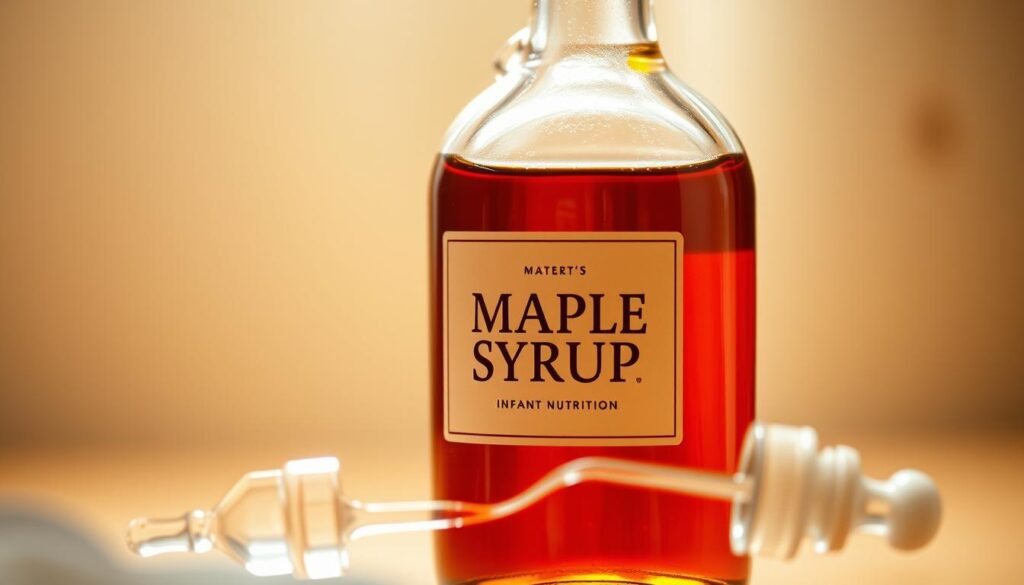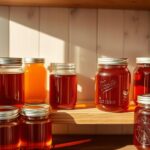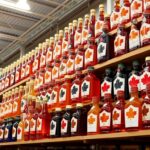Exploring infant nutrition can be tough for parents. They often wonder if they should introduce maple syrup to their babies. The answer is not simple. It depends on several factors before adding maple syrup to your baby’s diet.
Introducing maple syrup to babies needs careful thought. It’s important to consider their age, nutritional needs, and health risks. Even though maple syrup has some good nutrients, doctors suggest being cautious when introducing it.
Maple syrup’s journey from the forest to your table is fascinating. Skilled sugarmakers tap maple trees at the right time. They use old methods to make a sweetener full of nutrients, which interests parents looking for natural foods for their babies.
It’s key to know what maple syrup is made of and its safety before giving it to your baby. The different grades of maple syrup have different amounts of minerals and sugars. This affects how safe they are for babies to eat.
This guide will help you understand maple syrup and baby nutrition. You’ll learn about safety, when to introduce it, and how to do it right. You’ll get the info you need to make good food choices for your child.
We’ll look at the nutritional value, health benefits, and risks of maple syrup for babies. We’ll also share expert advice on adding maple syrup to your baby’s diet. Each part is filled with facts to help you make smart food choices for your baby.
Understanding Maple Syrup and Its Composition
Maple syrup is a natural sweetener with special nutrients. It comes from tapping maple trees. This process captures a mix of sugars and minerals that interest health-focused parents.
Pure maple syrup has many natural parts. It’s not just a simple sweetener. Its nutritional profile is different from processed sugars.
Natural Sugar Content in Pure Maple Syrup
The sugar in maple syrup includes several key types:
- Sucrose (primary sugar): 60-67% of total content
- Glucose and fructose: Remaining 33-40%
- Lower glycemic impact compared to refined sugars
Key Nutrients and Minerals Present
Maple syrup offers more than just sweetness. It has important minerals and trace elements:
- Manganese: Supports bone development
- Zinc: Boosts immune system function
- Calcium: Promotes strong bone growth
- Potassium: Supports cellular processes
Different Grades of Maple Syrup
Maple syrup is sorted into different grades. These are based on color and flavor:
- Golden Color, Delicate Taste: Lightest variety
- Amber Color, Rich Taste: Medium intensity
- Dark Color, Robust Taste: Strongest flavor profile
Knowing these differences helps parents pick the right maple syrup. It’s for their baby’s taste and nutritional needs.
Can Babies Eat Maple Syrup: Safety Guidelines
Parents often wonder if they can give maple syrup to their babies. It’s important to know the safety guidelines for giving maple syrup to infants. The main concerns are health risks and if it’s good for young children.
Is maple syrup safe for infants? Doctors say to be careful with maple syrup for babies under 12 months. The main risks are:
- Potential botulism exposure
- High sugar content
- Immature digestive systems
- Potential allergic reactions
Pediatric nutrition guidelines say to wait until a child is at least one year old before giving maple syrup. In the first year, babies need breast milk or formula as their main food. Their digestive systems can’t handle complex sugars well.
When thinking about maple syrup for babies, parents should remember these important points:
- Consult with a pediatrician before introduction
- Choose pure, organic maple syrup
- Start with minimal quantities
- Watch for possible allergic reactions
Professional healthcare providers always suggest waiting until after the first birthday to add sweets to an infant’s diet.
Always put your baby’s nutritional needs and developmental stage first when introducing new foods.
Age-Appropriate Introduction of Maple Syrup
Knowing when to introduce maple syrup to babies is important. It depends on their growth and nutritional needs. Parents should be careful and informed when adding maple syrup to their baby’s diet.
Pediatric nutrition experts say wait until a baby hits certain milestones before introducing sweeteners. The best time to introduce maple syrup is during key growth periods.
Developmental Milestones to Consider
Babies need to reach certain points before trying maple syrup:
- Ability to sit unassisted
- Established solid food consumption
- Developed digestive system (around 12 months)
- Demonstrated tolerance to various food textures
Signs of Readiness for Sweeteners
Look for these signs to know if your baby is ready:
- Consistent appetite for solid foods
- No history of food allergies
- Normal digestive function
- Interest in exploring new tastes
Recommended Starting Portions
Start with minimal quantities of maple syrup. A few drops in food can help see how your baby reacts. Always check with your pediatrician before adding new foods to your baby’s diet.
Pediatric nutrition guidelines emphasize moderation and careful observation during any new food introduction.
Health Benefits of Maple Syrup for Infants
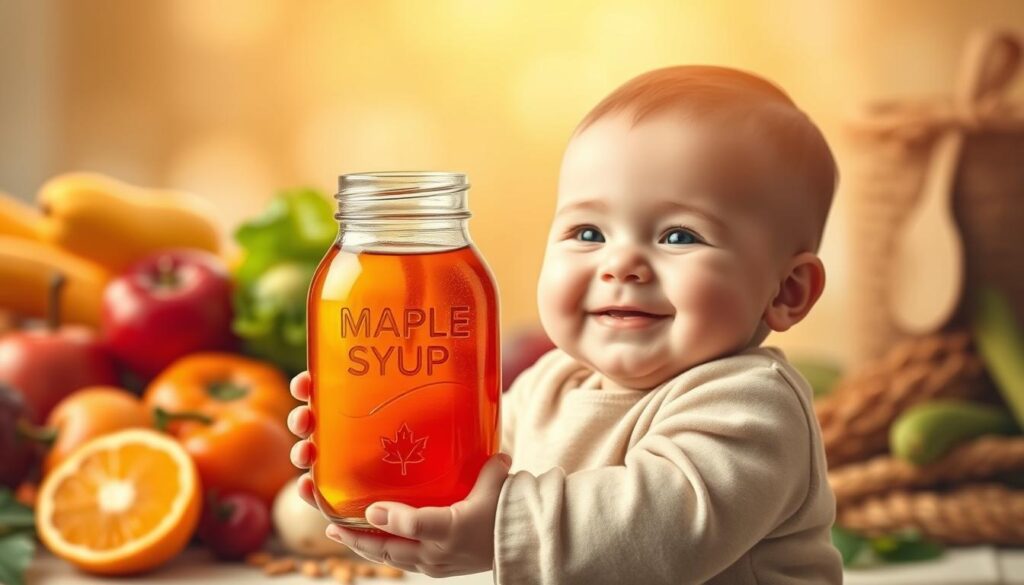
Maple syrup can be good for babies if given carefully. It has minerals and antioxidants that help their health. Parents should know about its benefits.
Pure maple syrup has nutrients that are good for growing babies. It has minerals that help with development:
- Zinc: Supports immune system function
- Manganese: Promotes bone development
- Calcium: Strengthens emerging bone structure
- Potassium: Assists muscle and nerve development
Studies show maple syrup has antioxidants that are good for health. Polyphenols in it might protect cells and help babies stay healthy.
| Nutrient | Benefit for Babies | Concentration Level |
|---|---|---|
| Zinc | Immune System Support | Moderate |
| Manganese | Bone Development | High |
| Calcium | Skeletal Growth | Moderate |
| Potassium | Muscle Function | Low-Moderate |
Maple syrup has good nutrients, but doctors say babies should only have a little. Always check with a doctor before adding new foods to a baby’s diet.
Potential Risks and Safety Concerns
Parents often wonder if maple syrup is safe for their babies. It’s important to know the risks before giving it to them. Maple syrup is tasty but needs careful thought before adding it to a baby’s diet.
There are several safety concerns to consider when thinking about maple syrup for babies. These risks involve different factors that need careful thought.
Botulism Risk Assessment
Maple syrup can be a big risk for infant botulism. Raw or unpasteurized syrup might have harmful bacteria. These bacteria can be very dangerous for babies under 12 months.
- Avoid maple syrup from unknown sources
- Choose commercially processed, pasteurized maple syrup
- Check for proper sealing and packaging
- Verify the production date and storage conditions
Sugar Content Considerations
Maple syrup has a lot of sugar, which is hard for babies to handle. Too much sugar can cause health problems and affect their growth.
- Limit maple syrup intake for babies
- Consult pediatricians before introduction
- Monitor infant’s reaction carefully
- Use minimal quantities if approved
Allergic Reaction Signs
It’s key to watch for signs of allergic reactions when introducing maple syrup. Careful observation is vital to keep the child safe.
- Watch for skin rashes
- Monitor breathing difficulties
- Check for digestive disturbances
- Observe facial swelling
Always prioritize your infant’s health and consult healthcare professionals before introducing new foods.
Choosing the Right Type of Maple Syrup for Your Baby
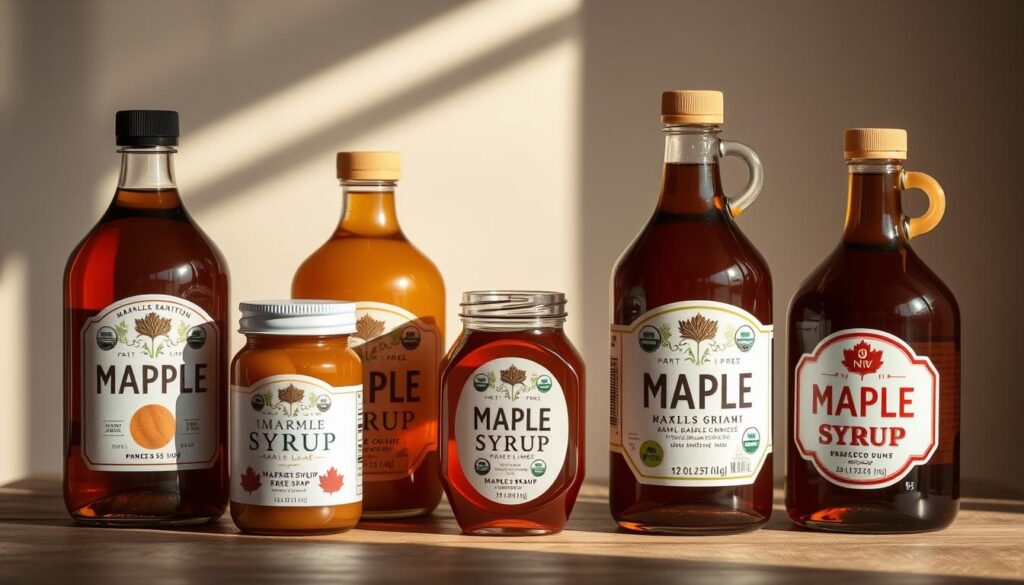
Choosing the right maple syrup for babies is important. Parents should look for pure, minimally processed options. These support their baby’s nutrition.
When picking maple syrup for babies, keep these points in mind:
- 100% pure maple syrup with no added sugars
- Organic certification preferred
- Grade A, Light Amber variety recommended
- No artificial preservatives or additives
The quality of maple syrup is key for babies. Pure maple syrup has minerals like manganese, zinc, and calcium. These can help meet an infant’s nutritional needs.
Pediatric nutritionists advise checking labels carefully. Look for brands that are open about where and how they make their syrup.
| Maple Syrup Grade | Infant Suitability |
|---|---|
| Grade A, Light Amber | Optimal for babies |
| Dark Color | Strong flavor, less recommended |
| Very Dark | Not suitable for infants |
Introduce maple syrup slowly, starting with small amounts. Always check with your pediatrician first. Maple syrup recommendations for babies stress moderation and watching for allergies.
How to Introduce Maple Syrup to Your Baby’s Diet
Introducing maple syrup to babies needs careful thought and a smart plan. Parents must learn how to introduce maple syrup safely and correctly.
When you’re ready to add maple syrup to your baby’s meals, pay close attention to a few important details. It’s not just about adding sweetness to their food.
Safe Preparation Methods
Getting maple syrup ready for your baby is key. Here are some important steps:
- Always use pure, organic maple syrup without additives
- Dilute maple syrup with water to reduce sugar concentration
- Start with extremely small quantities – no more than 1/4 teaspoon
- Ensure syrup is at room temperature before serving
Best Times of Day for Introduction
Timing is everything when introducing maple syrup to babies. The best times are:
- Morning meals when babies are most alert
- Mid-morning snack times
- Avoid introducing during evening or bedtime routines
Pediatric nutritionists say wait until babies are at least 12 months old. This helps avoid digestive issues and ensures they get the most nutrients.
Alternative Natural Sweeteners for Babies
Parents looking into maple syrup for their babies often want to know about other safe, healthy sweeteners. These options help balance introducing sweet tastes to a baby’s diet.
When thinking about maple syrup for babies, several natural sweeteners come into play:
- Date Syrup: Rich in minerals and fiber, date syrup offers a nutrient-dense alternative
- Fruit Purees: Naturally sweet and packed with vitamins
- Raw Honey (only after 12 months due to botulism risk)
- Stevia extract (in minimal quantities)
Each sweetener has its own nutritional benefits. Maple syrup is special because it’s full of minerals like zinc and manganese. These minerals help babies grow and develop.
Parents should be careful with sweeteners. The American Academy of Pediatrics says to limit added sugars in baby diets. Maple syrup should be given to babies in small amounts and only after talking to a pediatric nutritionist.
Natural doesn’t always mean unrestricted – moderation is key in infant nutrition.
When choosing natural sweeteners, focus on:
- Nutritional value
- Minimal processing
- Age-appropriate introduction
- Potential allergenic properties
Important Differences Between Pure and Artificial Maple Syrup
Parents looking into maple syrup for babies need to know the big differences between pure and artificial syrup. Pure maple syrup has more nutrients than artificial syrup. This makes it a better choice for babies.
Pure and artificial maple syrup are not just different in taste and look. Pure syrup comes straight from maple tree sap. Artificial syrup is made from corn syrup and chemicals.
Decoding Product Labels
When picking maple syrup for babies, reading labels carefully is key. Look for signs of real syrup:
- 100% pure maple syrup designation
- Single ingredient: maple sap
- USDA organic certification
- Grade A or Grade B classifications
Understanding Processing Methods
How syrup is made changes its nutritional value. Is maple syrup safe for infants? Yes, if it’s pure and processed little. This keeps in the good stuff like minerals and antioxidants.
“Not all maple syrups are created equal. Parents must prioritize purity and quality.” – Nutritional Experts
Artificial syrups lose nutrients in chemical processing. Pure syrup, made the old way, keeps important minerals like zinc and potassium.
Expert Recommendations on Sweeteners for Infants
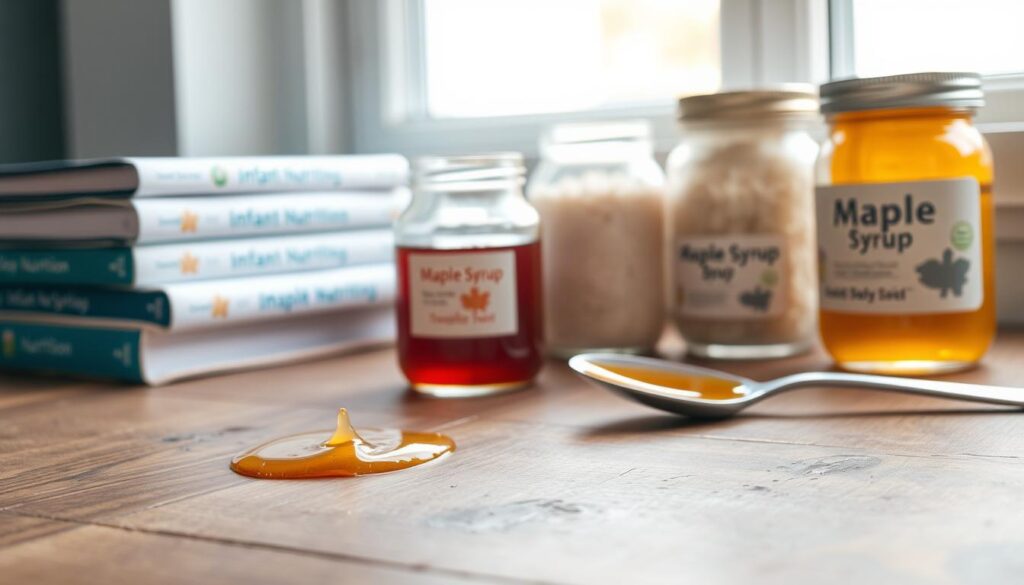
Pediatric nutrition experts give important advice on sweeteners for babies. They say it’s key to think about when and how to add sweeteners. This depends on the baby’s age and what they need to eat.
Doctors usually say to wait until a child is older before giving them sweeteners. The American Academy of Pediatrics says wait until a baby is at least 12 months old. This is when they are ready for maple syrup.
“Introducing sweeteners too early can disrupt healthy eating patterns and potentially lead to long-term dietary challenges,” notes Dr. Emily Rodriguez, pediatric nutritionist.
- Wait until baby is 12+ months old
- Use pure, organic maple syrup
- Introduce in minimal quantities
- Monitor for possible allergic reactions
When thinking about maple syrup for babies, experts say to use it carefully. Pure maple syrup has natural sugars and some minerals. But, it should not replace the important nutrients from breast milk or formula.
Nutritionists suggest choosing Grade A light or medium amber maple syrup. It has fewer additives and keeps more of its natural nutrients. Always talk to your pediatrician before adding new foods to your baby’s diet.
Common Myths About Maple Syrup and Babies
Parents often hear many wrong ideas about maple syrup and babies. Knowing the truth can help make better choices about maple syrup for babies.
- Myth: Maple syrup is safe for babies of any age
Pediatric nutritionists say no to maple syrup for babies under 12 months. It’s too sweet and can cause botulism.
- Myth: All maple syrups are equally nutritious
Not all maple syrups are the same. Pure, organic maple syrup has more good stuff than others.
When looking into maple syrup and babies, it’s key to know what’s real and what’s not. Is maple syrup safe for infants? It depends on the baby’s age and how they’re growing.
| Myth | Reality |
|---|---|
| Maple syrup is a healthy substitute for sugar | It has minerals, but use it sparingly in kids’ diets |
| Babies can consume maple syrup freely | Only small amounts are okay after 12 months |
Talking to pediatric nutritionists is the best way to learn about maple syrup in a baby’s diet. Always choose balanced, age-right nutrition.
Storing and Handling Maple Syrup Safely
Storing maple syrup right is key to keeping it safe and good for babies. Parents need to follow important storage tips. This helps keep the syrup’s nutrients and stops germs.
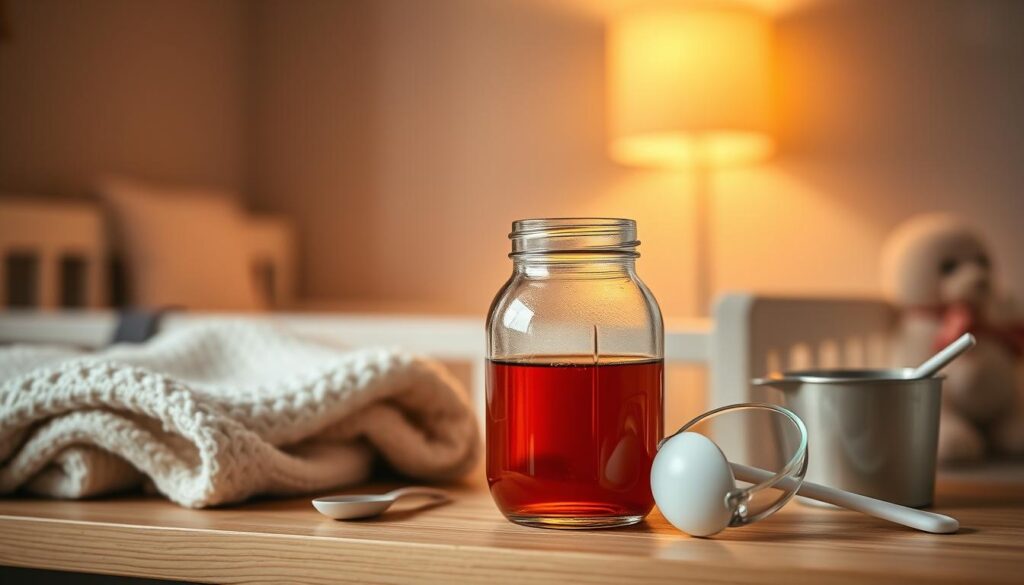
Maple syrup has sugars that can draw in bacteria and mold if stored wrong. Keeping it safe is important for babies.
Optimal Storage Conditions
- Store unopened maple syrup in a cool, dark pantry
- Keep temperature consistent between 50-70°F
- Seal containers tightly after each use
- Refrigerate after opening to extend shelf life
Signs of Maple Syrup Spoilage
| Spoilage Indicator | Action Required |
|---|---|
| Mold growth | Discard immediately |
| Unusual odor | Do not use |
| Crystal formation | Gently reheat or discard |
Always check maple syrup before giving it to babies. This ensures safety and quality.
Incorporating Maple Syrup into Baby-Friendly Recipes
Adding maple syrup to baby food can be a fun journey for parents. It makes meals tasty and nutritious. Pure maple syrup is a great way to add sweetness without harming your baby’s health.
Here are some tasty and healthy recipe ideas for maple syrup in baby food:
- Maple-Infused Oatmeal: Mix a little maple syrup into warm oatmeal for a yummy flavor
- Maple Yogurt Parfait: Add a bit of maple syrup to plain yogurt for a sweet treat
- Baked Sweet Potato Mash: Use a maple syrup glaze for a natural sweetness
- Maple Banana Puree: Mix mashed banana with a small amount of maple syrup
Remember these safety tips for maple syrup recipes:
- Wait until your baby is at least 12 months old
- Choose pure, organic maple syrup
- Start with small amounts
- Watch for any signs of allergy
“Maple syrup can be a nutritious addition to your baby’s diet when introduced carefully and in moderation.” – Pediatric Nutrition Expert
| Recipe | Age Recommendation | Serving Size |
|---|---|---|
| Maple Oatmeal | 12-18 months | 1 teaspoon per serving |
| Maple Yogurt | 12-24 months | 1/2 teaspoon per serving |
| Sweet Potato Mash | 12-15 months | 1 teaspoon per serving |
Always talk to your pediatrician before trying new foods. Every baby is different, so their needs vary.
Conclusion
Deciding if babies can eat maple syrup needs careful thought and expert advice. Parents should introduce maple syrup to babies with caution after their first year. It’s important to do it in small amounts and with an eye on the baby’s health.
Pediatric nutrition experts say to wait until a baby is at least 12 months old before giving them maple syrup. This helps avoid health problems and lets the baby’s body get used to natural sweeteners. Talking to healthcare professionals is key for making the right food choices for your baby.
Introducing maple syrup to a baby’s diet means knowing the good and bad, and when it’s the right time. Always choose pure, high-quality maple syrup and keep portions small. Opt for organic, unprocessed maple syrup for the best nutrition for your growing baby.
Good parenting is about finding the right balance between trying new foods and keeping things safe. Maple syrup can be a sweet treat for kids when introduced carefully. It adds natural sweetness and trace minerals that help with healthy eating.

